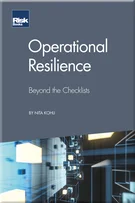BEICFs modelling and integration into the capital model
Introduction
Challenges of operational risk advanced capital models
Part I: Capture and Determination of the Four Data Elements
Collection of operational loss data: ILD and ED
Scenario analysis framework and BEICFs integration
Part II: General Framework for Operational Risk Capital Modelling
Loss data modelling: ILD and ED
Distributions for modelling operational risk capital
Scenario analysis modelling
Exposure-based approaches
BEICFs modelling and integration into the capital model
Hybrid model construction: Integration of ILD, ED and SA
Derivation of the joint distribution and capitalisation of operational risk
Backtesting, stress testing and sensitivity analysis
Regulatory approval report
Evolving from a plain vanilla to a state-of-the-art model
Part III: Use Test, Integrating Capital Results into the Institution’s Day-to-day Risk Management
Strategic and operational business planning and monitoring
Risk/reward evaluation of mitigation and control effectiveness
Appendix 1: Credibility theory
Appendix 2: Mathematical optimisation methods required for operational risk modelling and other risk mitigation processes
Business risk quantification
After describing the modelling of internal loss data (ILD), external loss data (ED) and scenario analysis (SA) in Chapters 4, 6 and 7, we now look at the modelling of business environmental and internal control factors (BEICFs), the fourth and last of the data elements of an operational risk capital model.
This chapter will present methods for the use of BEICFs in capital calculations. BEICFs are metrics (internal audit, risk and control self-assessment (RCSA), key risk indicators (KRIs) – see Chapter 3) that point to weaknesses permitting operational failures, and hence they can provide a forward-looking character to the capital model. The benefits of the use of BEICFs are recognised by the Basel Committee on Banking Supervision “Operational Risk – Supervisory Guidelines for Advanced Measurement Approaches” (BCSG-AMA) when it says: “BEICFs are operational risk management indicators that provide forward-looking assessments of business risk factors as well as a bank’s internal control environment”.
We introduced BEICFs and their use as an input into SA in Chapter 3, and in the following sections we present various methods for using BEICFs directly into the capital
Copyright Infopro Digital Limited. All rights reserved.
As outlined in our terms and conditions, https://www.infopro-digital.com/terms-and-conditions/subscriptions/ (point 2.4), printing is limited to a single copy.
If you would like to purchase additional rights please email info@risk.net
Copyright Infopro Digital Limited. All rights reserved.
You may share this content using our article tools. As outlined in our terms and conditions, https://www.infopro-digital.com/terms-and-conditions/subscriptions/ (clause 2.4), an Authorised User may only make one copy of the materials for their own personal use. You must also comply with the restrictions in clause 2.5.
If you would like to purchase additional rights please email info@risk.net








